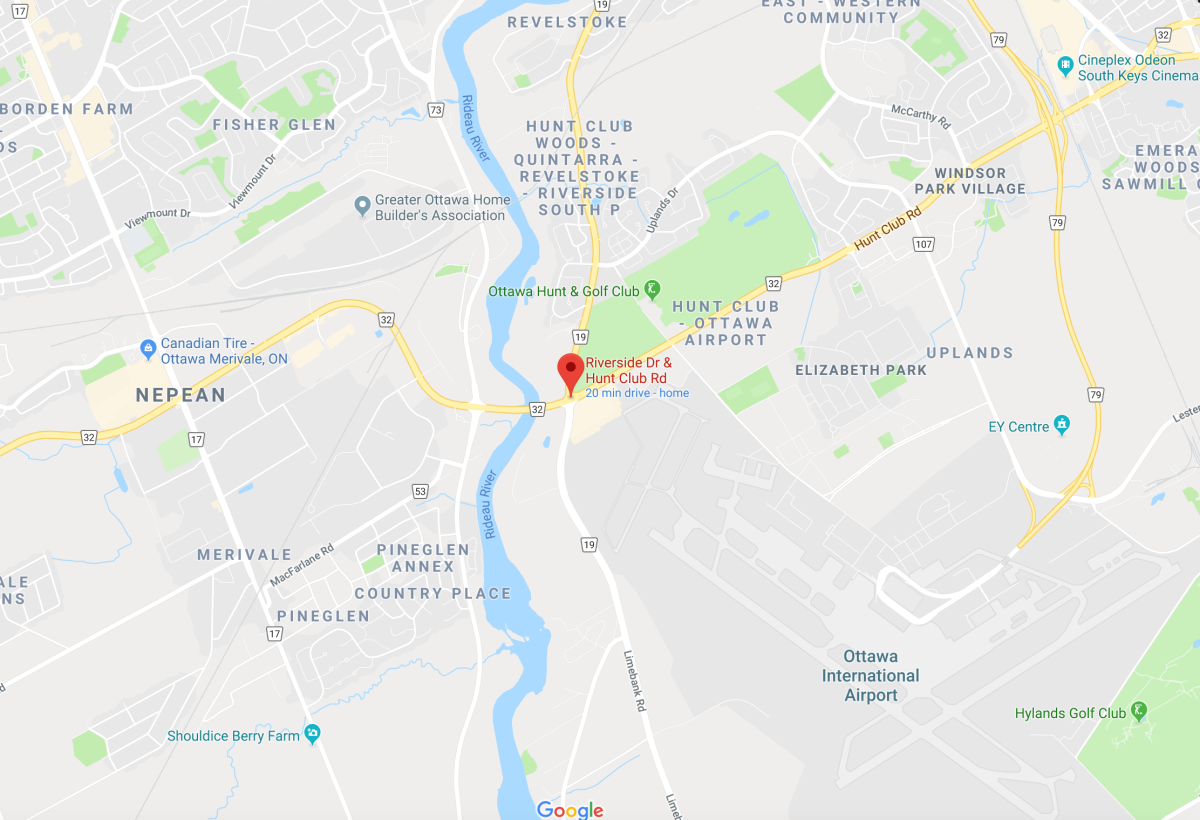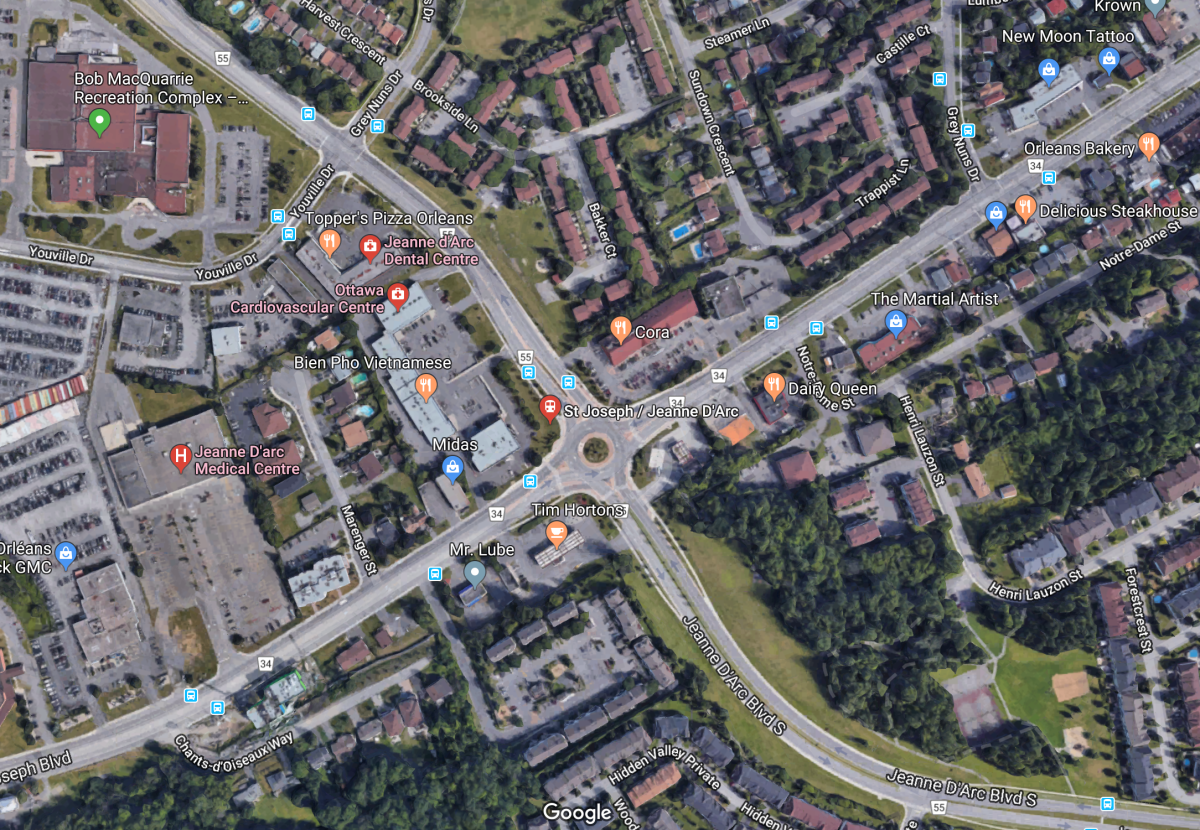With the exception of 2013, the busy junction of Hunt Club Road and Riverside Drive in Ottawa’s south end has been the city’s worst signalized intersection for traffic collisions every year since 2010, according to data published by the City of Ottawa.

The city’s latest annual road safety report released Friday shows there were 45 collisions — involving either vehicles, motorcycles, cyclists, and pedestrians — at Hunt Club Road and Riverside Drive in 2017, marking the fourth year in a row the intersection has claimed top spot for traffic accidents.
In the years that the intersection, located just west of the Ottawa International Airport, didn’t claim the title of worst collision hot spot, it consistently made top three.
Frank D’Aoust, acting inspector with Ottawa Police Service, said it’s difficult to pinpoint one particular reason why Hunt Club and Riverside sees more accidents than other similarly large intersections in the city. However,”the sheer amount of traffic going through on a daily basis,” compounded by population growth in Riverside South, are contributing factors, he said.
“More and more road users are travelling through that section of road,” D’Aoust said in a phone interview Monday. “And when we look at the reportable collisions by hour of day, they jump dramatically across the city during the afternoon rush hour … from the 3 p.m. to 6 p.m. time frame.”
D’Aoust said 33 per cent of the collisions police documented in 2017 were rear-end collisions. Given that area of Hunt Club Road allows for “60 or 80 km/h,” he suggested that a cocktail mix of speeding, tailgating and distracted driving might be causing more accidents at major intersections.

Get daily National news
“Either the driver is doing something else while the traffic is stopping, or they’re simply following too close and they’re not giving themselves enough room to stop,” he said.
The city of Ottawa has been compiling and publishing road safety statistics documented by the Ottawa Police Service over the last decade. The earliest report available online contains data from 2007.
Since 2011, the annual road safety reports have broken down traffic collision numbers by totals, injuries, fatalities, types of road user, location, and by hour, day and month.
None of the collisions recorded at that Hunt Club Road and Riverside Drive since 2011 were fatal, police reported.
Still, there have never been fewer than 33 collisions (the lowest number recorded, in 2009) in a single year at Hunt Club and Riverside since 2007. The highest number of collisions recorded at that intersection, during that same period, was 60 accidents in 2015.
Other collision hotspots in Ottawa
The intersection that hosted the second highest number of collisions in 2017, with 41 accidents, was West Hunt Club Road and Woodroffe Avenue — just a six-minute drive west from the top spot. This major intersection took first place, however, in 2007, 2008 and 2010.
In third place in 2017 was Baseline Road and Woodroffe Avenue in Ottawa’s west end, just northwest of Algonquin College, with 40 recorded collisions. This intersection made the top spot in 2009 — and has more often than not made the top 10 over the last decade of traffic collision data.
All three of those intersections are major, high-traffic crossings with two to five lanes going in each direction, turn lanes gliding across the centre and pedestrian crosswalks.
None of the collisions recorded at the top 12 intersections for 2017 resulted in fatal injuries, according to the city’s data for that year. There was only one major injury at Merivale Road and West Hunt Club Road, the statistics showed.
Asked whether Ottawa police are recommending any changes to major intersections like these to help reduce the likelihood of collisions — such as reducing the speed limit or the timing of the traffic lights — D’Aoust said, “those are all things that need to be considered,” but added that enforcement and education by police are priorities.
“Through enforcement and our interactions with the public, we’re educating them and trying to make our roads safer, whether it’s focusing on red light running, speeding and distracted driving,” he said.
List of top hotspots leaves out non-signalized intersections, like roundabouts
The list of top hotspots for collisions doesn’t include accidents at intersections without traffic lights. In 2017, for example, the roundabout at St. Joseph Boulevard and Jeanne D’Arc Boulevard in Orléans, in the east end of the city, surpassed Hunt Club Road and Riverside Drive’s 45 collisions significantly, with 54 accidents.
While that count may seem steep, D’Aoust insisted these roundabouts are significantly safer than other types of intersections.
“They may be small, minor fender-benders, but the risk of injuries is far less,” he said. “When we look at injuries and collisions, the risk of fatal collisions at a roundabout goes down 90 per cent.”
D’Aoust said roundabouts are still “fairly new” to Ottawa’s roads system and “a lot of the time, people aren’t familiar with what to do at these types of intersections.”












Comments